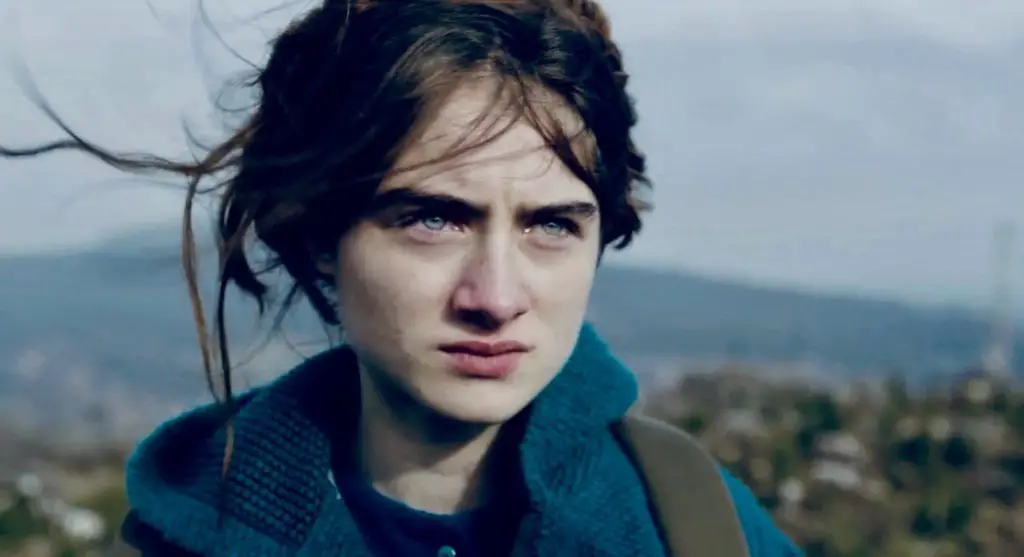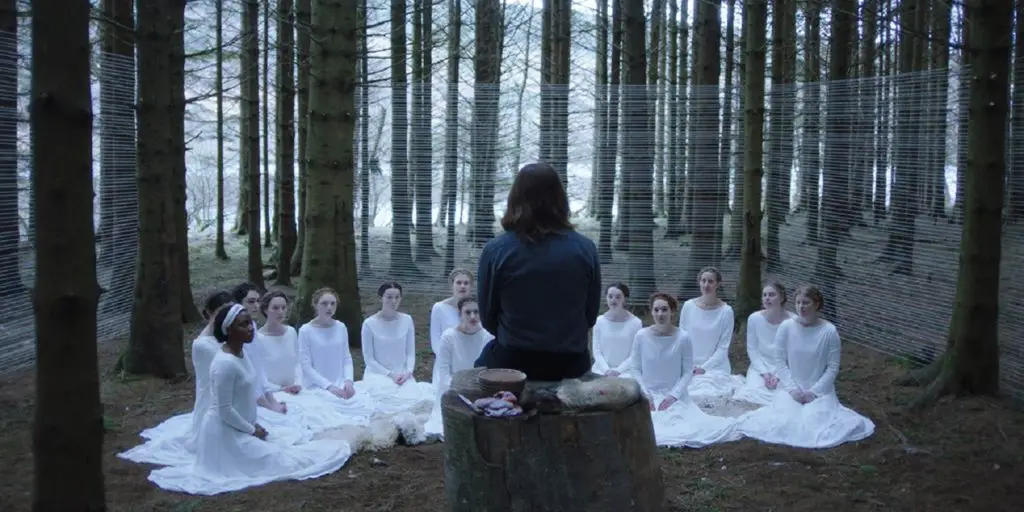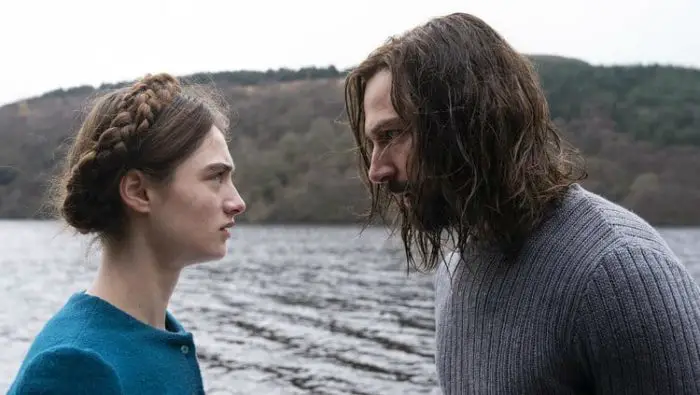Patriarchal Sect And Liberation: Analysis Of The Scandalous Film The Other Lamb (2019). The Other Lamb : Plot Summary, Meaning Of The Film, Explanation Of The Ending, Similar Movies.
Genre: drama, thriller
Year of production: 2019
Directed by: Malgorzata Szumowska
Actors: Raffy Cassidy, Michiel Huisman, Denise Gough
Malgorzata Szumowska is considered one of the most influential independent female directors of the new era. In her paintings, she loves to show the life of ordinary people and is not afraid to bring up difficult topics. The film “Other Lamb” was no exception. The plot and meaning of the film The Other Lamb is rather non-standard: this tape is about a closed community and about the study of the psychology of its members.
What is the movie about
Brief description of the content of the film The Other Lamb. In the center of the plot, Sela is a young girl living in a small community settlement surrounded by forest. At the head of the community is the only man in the village, the Shepherd. He daily conveys to the flock pseudo-religious ideas about being chosen, spiritual enlightenment and advancing along the thorny path to the earthly paradise.
 Raffi Cassidy played the role of Sela. Frame from the film.
Raffi Cassidy played the role of Sela. Frame from the film.
He divides the women and girls of the community into three groups: wives, delinquents and daughters. They all wear red, blue or white clothes.
Young Sala, who increasingly catches the eyes of the Shepherd, understands that soon she will also become one of his “wives” and is looking forward to this event with great excitement. She often sees various fantasy visions and he inspires her that she is special …
The family lives far from civilization and breeds sheep. Their life flows calmly – exactly until a representative of the authorities comes to the Shepherd and asks them to leave their homes.
In the community created by the Shepherd, women and girls face daily psychological pressure and physical violence. But to many of them it seems that nothing special is happening. Like sheep blindly following the shepherd, accustomed to the patriarchal way of life, they believe that everything is going as it should.
Soon the community goes in search of a new place. During this journey, Sala becomes close to one of the women, Sarah, who warns her that the Shepherd, whom the girl simply idolizes, loves to hurt. Seeing the scars on Sarah’s chest, Sela thinks seriously.
After some time, Sela, who previously believed that her mother died in childbirth, learns from Sarah that this is not so. Her mother, like Sarah, were the Shepherd’s first wives. One day the unfortunate woman got an infection, and the Shepherd refused to take her to the hospital, and she died.
Rebellious thoughts are roaming in Sarah’s head: she no longer believes in the Shepherd, but she cannot imagine life outside the community, and she has nowhere to go.
Some time later, one of the “wives” dies in childbirth in front of Sela. The fate of the newborn boy is of little interest to the leader of the community, and he would have left him to die if some of the women had not begun to resent.
Toward the end of the film, the Shepherd, suddenly realizing that a revolution is brewing in the community and his authority is in question, resorts to intimidating his “sheep”. He beats one of the women, and then, calling Sala to him, rapes her. At this time, the girl vividly imagines how all the women of the community gather together and kill their tormentor …
 Shepherd and daughters. Frame from the film.
Shepherd and daughters. Frame from the film.
Ending explanation The Other Lamb
The explanation of the ending is as follows: at the end of the picture, the Shepherd calls Sala and several other women to him and informs them that they should become his new wives. The mise-en-scene takes place on the shore of a lake, on which women’s clothes lie. There is no one else near the Shepherd. When asked where the other women have gone, he replies that they have gone into a different life.
Sala’s patience wears out and she openly opposes him. He tries to physically subdue her, but the enraged girl gives him a decisive rebuff. This is where the scene ends.
A few days later, the police find several dead women and the body of the Shepherd, with ram’s horns tied to his head, suspended between two trees. Meanwhile, the remaining women, along with Sela, gather at the waterfall at the site of their former settlement.
The meaning of the ending of the film The Other Lamb is that the women, having killed their tormentor, chose a new Shepherd – Sala. That is, from obsolete patriarchy, they moved into matriarchy.
The finale of the film, which at first glance proclaims the triumph of freedom, is actually tragic. Girls, cut off from reality for many years, unfortunately, will not be able to live a full life. They are also unlikely to be able to integrate into society – however, they probably do not want to do this themselves. However, the police, having discovered their location, will be able to bring a number of charges against them …
The meaning of the film The Other Lamb
Many viewers in their analysis of the film The Other Lamb call the picture “disgusting” and “immoral”. Indeed, many of the ideas reflected in it are inhumane. What strikes viewers the most is that many women came to the community and remained in it voluntarily.
The key to this behavior of the “sheep” is that young girls simply did not know that it could be somehow different, and adult women saw in the community a good “green” alternative to a world in which, in their opinion, there was no place. So, trying to get out of one trap, they, without realizing it, drove themselves into another.
The point is that if social law reigns in the outside world, lawlessness generally rules in their small community. Having lived for a long time under the leadership of the Shepherd, most women are unable to return to normal life, because their consciousness and habits are completely distorted.
The film The Other Lamb does not tell a single personal story through which one could understand the reason for their blind obedience to the Shepherd. However, the logic of their actions can be explained.
The point is that the community shown in the film is an ordinary sect. The leaders of such destructive organizations are excellent manipulators with the ability to persuade. They instantly read the needs of a person and offer what he lacks.
One of the reasons that bring people into such “communities” is the need for love and friendship. It can be assumed that before meeting the Shepherd, women were under stress or suffered from loneliness. The leader of the sect promised them to become a caring husband and father, promised them a safe harbor and a paradise on earth, in which all his wives and children would coexist in peace and harmony. He tried to convince the community that together they are a united, loving and spiritually enlightened family. At the same time, he inspired women that they were not only beautiful and unique, but also full of insignificance, who would not survive without him and his support.
 Michiel Huisman as Shepherd and Raffi Cassidy as Sela. Frame from the film.
Michiel Huisman as Shepherd and Raffi Cassidy as Sela. Frame from the film.
The interpretation of the image of the Shepherd is extremely simple – this is a typical psychopath. Afraid of losing his status in the future, he forces his “wives” to get rid of male babies. Trying to look like Christ outwardly, he is a real monster that hell misses …
The film The Other Lamb is filled with symbolism. Its original name (“Other Lamb”) can literally be translated as “The Other Lamb”. This is the hidden meaning of the picture.
The shepherd perceives the community as a flock of sheep, which, day after day, resignedly perform a series of physical and physiological actions. With sheep, which in many cultures symbolize innocence and sacrifice, the filmmakers compare inexperienced girls preparing to become the wives of their leader. The other lamb is Sela, who was able to recognize the predatory nature of the Shepherd.
Dreaming of liberation, a girl often imagines a beautiful naked woman against the backdrop of lush wildlife, revealing her secrets to her. This image can be correlated with Eve in the Garden of Eden, and with the archetypal image of a woman as a great mother-grandmother.
The Shepherd himself can be compared to a ram, which zealously guards its flock. At the end of the picture, women, raising ram’s horns on the head of their tormentor, seem to reveal his true essence.
The colors of the clothes of the members of the community carry a special metaphorical meaning. Red, blue and white are the colors of the vestments of the Virgin Mary. Red dresses, symbolizing physiological maturity, are worn by “wives”, turquoise-blue, representing spiritual purity in Christianity, is the color of young girls and girls. White robes are worn only during rituals. They symbolize enlightenment or spiritual rebirth.
It can be assumed that the essence of the film lies on the surface: it talks about the desired liberation from patriarchy. However, The Other Lamb is not only about feminism. One of the main ideas of this unusual picture is the need to free the mind from manipulation and dogmas and stereotypes imposed on it.
 Frame from the film.
Frame from the film.
Similar films
Here are a few films similar in meaning to The Other Lamb:
- Midsommar (USA, Sweden, 2019). A group of anthropology students come to Sweden to see an interesting pagan rite. It soon becomes clear to them that the members of the community that sheltered them are not very harmless;
- “Apostle” (UK, USA, 2018). The girl is kidnapped for ransom. Her brother is sent in search of her, whom everyone considers dead;
- “Mysterious Forest” (USA, 2004). A small village is surrounded by gloomy forests inhabited by terrible monsters. One day, the truce between humans and monsters is broken.







